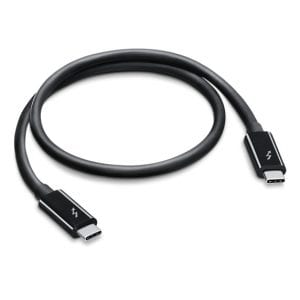New Era of Data transfer
There are a number of USBs and each of them has different properties relating to different tasks, we are using these connectors from last two decades now and has helped us to connect external devices to PCs. USBs are one of the most important ways to connect and interact with electronic devices. But as now electronic devices are becoming thinner day by day, shrinking to half an inch so USB like type A can no longer fit into these notebooks. Therefore to replace these manufactures introduced technology like USB Type C and Thunderbolt port.
Different Type of USB ports
| Type | Top Speed | Power Output | Power Direction | Cable Configuration | Release |
| USB 1.1 | 12Mbps |
2.5v 500mA |
Host to peripheral | Type-A to Type-B | 1998 |
| USB 2.0 | 480Mbps | 2.5v, 1.8A | Host to peripheral | Type-A to Type-B | 2000 |
| USB 3.0 | 5Gbps | 5v, 1.8A | Host to peripheral | Type-A to Type-B | 2008 |
| USB 3.1 | 10Gbps | 20v, 5A | Bi-directional | Type-C at both ends | 2015 |

Importance of USB Type C and Thunderbolt 3
The first thing to know is that USB Type C is not a universal standard for USB 1.1, USB 2.0, USB 3.0 or the very latest USB 3.1 is. USB-C is all about the physical connection, like with microUSB and miniUSB. USB-C don’t focus on what connection can do in terms of data transfer speed or any improvement in the feature as previous upgrades did, indeed it’s a replacement for both ends of a cable, so there is no need to flip your cable to find a correct connector for the device. For example, to connect a Mobilephone with your PC you need to connect USB Type A to PC and Type B to the mobile phone.
USB Type-C ports can support a variety of different protocols allowing you to have adapters that can output HDMI, Displayport, DVI and other types of connections within a single type of port. Additionally, as Most smartphone chargers handle 5 volts at 2 amps, while computers need 20 volts at 5 amps. USB 3.1, and the new Type-C connectors by extension supports power variability of 100 watts, allowing for one cable that can charge at the lower-end smartphone level or higher-end desktop level.
Features of USB-C
- Small: The new port is half the width and one-third the height of a standard USB connector and only slightly larger than Apple’s Lightning or the micro-USB connectors.
- Reversible: Unlike older USB cable, it doesn’t matter which side is up.
- Fast: Type-C ports transfer data up to 10 gigabits per second.
- Powerful: The new connector provides up to 100 watts of power, enough to power a laptop.
- Flexible: Users are able to connect older devices to Type-C ports, even devices that use non-USB technologies, like VGA, Ethernet and DisplayPort.

On the other hand, Intel’s Thunderbolt 3 is newer version of Thunderbolt connector Co-designed by Apple and Intel, which lets you to transfer data at speed 40 Gbps, which is twice faster than Thunderbolt 2 which can throughput data at 20 Gbps and four-time faster than USB Type C which transfer data at speed of 10Gbps. Additionally, Thunderbolt 3 has the same design as USB-C which gives it an edge over other connectors. But, to take complete advantage of Thunderbolt you have to use an Active cable. Active optical cables are made of plastic and glass, similar to fibre optic cables. They use the light transmission to transmit data at speed of 40Gbps throughput, but their length varies from 6 feet up to 200 feet roughly.
The most exciting feature of Thunderbolt 3 is that now gamers can attach external graphics to their notebook and enjoy graphics intense games. But if you are interested in buying a gaming laptop with inbuilt graphics visit here.
Other benefits of using Thunderbolt 3 Connector
- 4 lanes of PCI Express Gen 3
- 8 lanes of DisplayPort 1.2 (HBR2 and MST)
- Supports two 4K displays (4096 x 2160 30bpp @ 60Hz)
- Power-Up 100W system changing, 15W bus powered devices
- Enables you with 10Gb Ethernet connection between computers
- Provide low latency for PCI Express audio recording
Also Read: How to Increase Pendrive/USB Data Transfer Speed
PCI Express? What is that
Peripheral Component Interconnect Express is a high-speed computer expansion bus, used in motherboard level connection as an expansion card interface.It has lot of benefits over previous standards of expansion, including higher maximum system bus throughput, lower I/O pin count and smaller physical footprint, better performance scaling for bus devices, additionally it has more detailed error detection and reporting mechanism and native hot-swap functionality.
Additionally, PCIe technology enables interface speeds of up to 1GB/s per client lane (PCIe 3.0), versus today’s SATA technology speeds of up to 0.6GB/s (SATA 3.0).
Let’s compare Bandwidths of PCIe of different Gen
| Bits | PCIe 1.x | PCIe 2.x | PCIe 3.0 |
| x1 | 250MB/s | 500MB/sec | 1GB/sec |
| x2 | 500MB/sec | 1GB/sec | 2GB/sec |
| x4 | 1GB/sec | 2GB/sec | 4GB/sec |
| x8 | 2GB/sec | 4GB/sec | 8GB/sec |
| x16 | 4GB/sec | 8GB/sec | 16GB/sec |
Every thing have some negative and Thunderbolt 3 also have some,
Disadvantage of Thunderbolt
- Expensive: The cable can cost ten times as much as a standard USB costs.
- Security vulnerability: The security of connection and data transmission is another problem of the Thunderbolt interface. Like other high-speed expansion buses such as PCI, FireWire, PC Card, and Express Card, this hardware interface is potentially vulnerable to direct memory access or DMA attacks. DMA attacks center on the principle of attaching an external malicious device to a computer to access the system memory, thus allowing the reading and writing of such, exposing of encryption keys, and installing of different types of malware. Thunderbolt interface can be used to load and execute malicious Option ROMs from attached peripheral or device. Execution can transpire even before the computer runs the operating system, thus allowing kernel invasion, logging of keystrokes, and exposure of encryption key.
- Small product ecosystem: very few products operate this technology and we can say that till now it is not for general users.
Certainly, most of the devices will be using technology like USB Type C and Thunderbolt 3 for high-speed data transfer and more convenient connections, giving us relief from the web of wire that we have in our drawer. Change is inevitable so does in technology speed of data transfer is increasing every year or so, regardless of complex networking, it’s interesting to analyze where we are heading to.
Also Read: How to Fix USB Device Not Recognized Error in Windows





